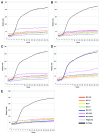Development of a high throughput assay for indirectly measuring phage growth using the OmniLog(TM) system
- PMID: 23275867
- PMCID: PMC3530525
- DOI: 10.4161/bact.21440
Development of a high throughput assay for indirectly measuring phage growth using the OmniLog(TM) system
Abstract
The conventional and most accepted method of measuring the lytic activity of a phage against its bacterial host is the plaque assay. This method is laborious, time consuming and expensive, especially in high throughput analyses where multiple phage-bacterial interactions are required to be monitored simultaneously. It can also vary considerably with the experimenter and by the growth and plating conditions. Alternatively, the lytic activity can be measured indirectly by following the decrease in optical density of the bacterial cultures owing to lysis. Here we describe an automated, high throughput, indirect liquid lysis assay to evaluate phage growth using the OmniLog(TM) system. The OmniLog(TM) system uses redox chemistry, employing cell respiration as a universal reporter. During active growth of bacteria, cellular respiration reduces a tetrazolium dye and produces a color change that is measured in an automated fashion. On the other hand, successful phage infection and subsequent growth of the phage in its host bacterium results in reduced bacterial growth and respiration and a concomitant reduction in color. Here we show that microtiter plate wells inoculated with Bacillus anthracis and phage show decreased or no growth, compared with the wells containing bacteria only or phage resistant bacteria plus phage. Also, we show differences in the kinetics of bacterial growth and the timing of appearance of phage resistant bacteria in the presence of individual phages or a cocktail of B. anthracis specific phages. The results of these experiments indicate that the OmniLog(TM) system could be used reliably for indirectly measuring phage growth in high throughput host range and phage and antibiotics combination studies.
Figures





References
-
- Stent GS. Molecular Biology of bacterial viruses. San Francisco: W. H. Freeman, 1963.
-
- Carlson K. Working with bacteriophages:common techniques and methodological approaches. In: Kutter E, and Sulakvelidze, A, ed. Bacteriophages: Biology and Application. Boca Raton, FL: CRC Press, 2004:437-94.
LinkOut - more resources
Full Text Sources
Other Literature Sources
